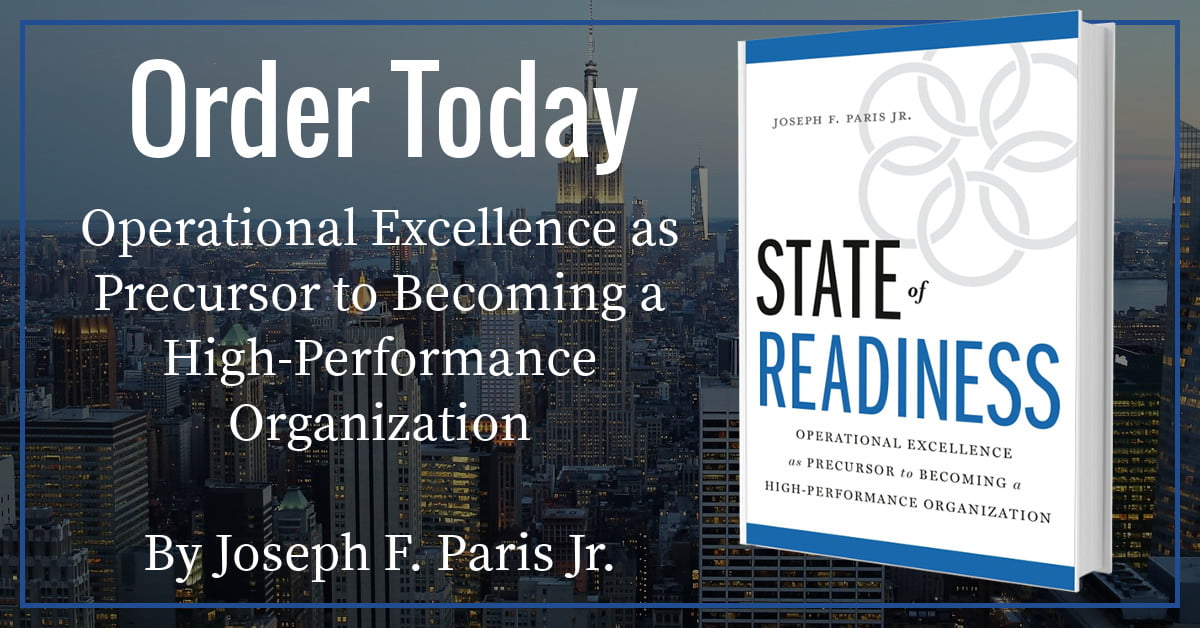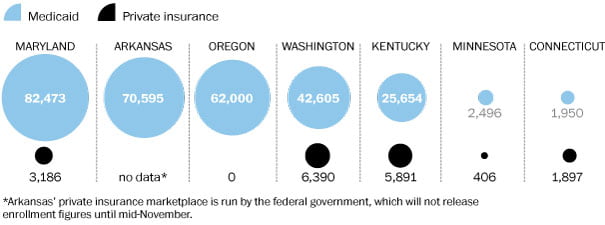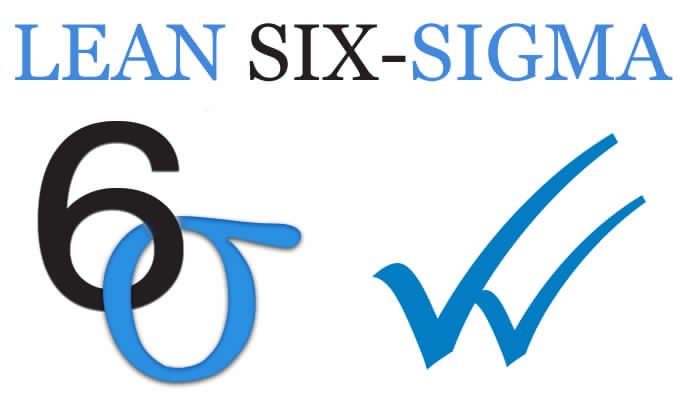You Only Get One Opportunity to Make a First Impression
Imagine this scenario: An upstart high-tech firm in Silicon Valley has an idea for an offering which promises to transform the lives of tens of millions of people across the United States. It has adequate funding and an abundance of time for product design and development leading-up to its launch.
To be sure, there are a large number of people who are suspicious and cynical. Some people believe the offering is over-hyped. Some believe that it simply won’t work. Some believe it is runs counter to legacy, nostalgia and tradition. Some believe that it will benefit few and harm many. And some believe that the status-quo is satisfactory, so why change it? But most have a “wait and see” attitude.
On the day of the big launch, the offering fails miserably. The problems range from not being able to access the system at all, to system failures when trying to place the order, to errors in the logic imbedded in the ordering system (with those forced to give inaccurate information just to proceed to the next step). Only single-digit percentages of those who want to buy the offering are successful in placing an order. Even those who are successful spend half the day just trying to place their order.
The company admits the launch was an abysmal failure – but promises the “glitches” will be fixed (they just don’t know when). What would be the impact on the company?
Would the consumer continue their rush to purchase the offerings? Would they retain their confidence in the company to deliver what was promised? Would they retain their faith in the company’s leadership as stewards of the company’s viability? Would they look to alternatives? Would they decide what they have is good enough – or that they can do without buying? If this were a public company, what do you think the analysts would say? What would happen to the stock-price?
And what if, by some series of events or even a miracle occurring, the company was able to launch its offering – albeit at some later date. Would the people be trusting and as keen to rush forward and buy?
You only get one opportunity to make a first impression.
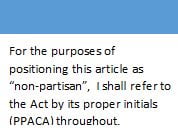 Such is the case of the “Patient Protection and Affordable Care Act” (PPACA) – commonly referred to in the media as the “Affordable Care Act” (ACA), or simply “Obamacare”.
Such is the case of the “Patient Protection and Affordable Care Act” (PPACA) – commonly referred to in the media as the “Affordable Care Act” (ACA), or simply “Obamacare”.
Regardless of whether the purchase is from an individual, a company, or the government; there are a few requisites that must exist for a person to agree to engage in a purchase transaction with another.
- Assess the need: Is there a marketplace for the offering?
- Create an offering to meet (or generate) the need.
- Generate market awareness for the offering.
- Expedite purchase execution by consumer
1st – Assess the Need: Is there a Marketplace?
The first step in creating an offering is to assess the potential marketplace for the offering. Who is the customer? Why would they buy? Who is going to actually buy? And why would they buy under PPACA versus some other vendor? I am certain that nearly everyone in the United States would agree that the costs associated with healthcare and health insurance for value received is ever-widening and that the bureaucracy is crushing. I am also certain that nearly everyone in the United States believes that the healthcare and healthcare insurance industries – when considered as a whole – are in dire need of end-to-end reformation and transformational change.
But for the purpose of this article, I am not going to debate whether I believe that transformational structural reform of the healthcare and health insurance industry in the United States is necessary (which I do), or whether I believe everyone in the United States must have some form of health insurance (which I do), or whether I believe that the PPACA is the piece of legislation that will deliver that transformation (which I don’t – but I also believe it should be re-engineered, not repealed).
You can read more of my analysis and thoughts on the on the subject of healthcare and health insurance value-for-cost in the United States in a previous article of mine; “Healthcare: No End in Sight – Poor Value at Unsustainable Costs”. Who is the customer? In this first step, I believe the government correctly identified their target customer namely as: those who are uninsurable, those who are presently uninsured, and those likely to remain uninsured. Not surprisingly, and according to the Kaiser Family Foundation, 38% of the estimated 47.3 million without health insurance have an income which is below the Federal Poverty Level (FPL) as established by the Federal Department of Health and Human Services – and over 75% have an income which is under 250% of the FPL (for a single, 250% is $28.7k and for a family of four it would be $58.9k).
Why would they buy? As with any insurance, the person who is likely to buy health insurance wants to protect something of value (namely, their property and assets), has the means to pay the premium, and makes a risk-assessment as to whether the insurance might be necessary during the period of coverage.
Who is going to actually buy? Given the above, it therefore stands to reason that a young single person without any assets to protect might go without insurance knowing that they will get the necessary care anyway in the case of an emergency (the most likely need) and also knowing that the healthcare provider is not able to be a threat against assets that do not exist. Whereas those who actually buy the insurance will be those; i) who have the ability to pay the premiums, ii) who have a very serious illness and need more intensive treatments than a visit to the emergency room will provide, or iii) have accumulated some wealth or property which might become at-risk should debts be accumulated due to healthcare related issues.
However, it is very important to keep in mind that the insurance offered under PPACA insurance is for costs related to the delivery of healthcare and not against lost income – so a protracted illness might still result in a threat to any accumulated wealth or property.
![]() Why would they buy from PPACA versus some other vendor? In a word, “affordability” as it is on a more moderate cost escalation trajectory than healthcare insurance premiums from private insurers. As in Medicaid and Medicare, there is tremendous pressures from the government on healthcare providers to contain costs. The trade-off, of course, is that private insurers have more flexibility and will (mostly) cover charges incurred by healthcare providers who might decline to participate with patients in the government programs and therefore considered more “elite”.
Why would they buy from PPACA versus some other vendor? In a word, “affordability” as it is on a more moderate cost escalation trajectory than healthcare insurance premiums from private insurers. As in Medicaid and Medicare, there is tremendous pressures from the government on healthcare providers to contain costs. The trade-off, of course, is that private insurers have more flexibility and will (mostly) cover charges incurred by healthcare providers who might decline to participate with patients in the government programs and therefore considered more “elite”.
For this step, I believe that the “need” exists and was properly assessed in general, but the Fatal Flaw at this First Stage of market analysis was that not enough market research was performed on the actual consumer – who was clearly misunderstood by the lawmakers in Washington when they crafted the Act.
If we examine the data on Poverty in the States from data obtained by the US Census Bureau as shown in the graph, it is unsurprising that we can see that those who stand to benefit most from the PPACA are the those who are at or near living in poverty (75.9 million people, or nearly 25% of the population).
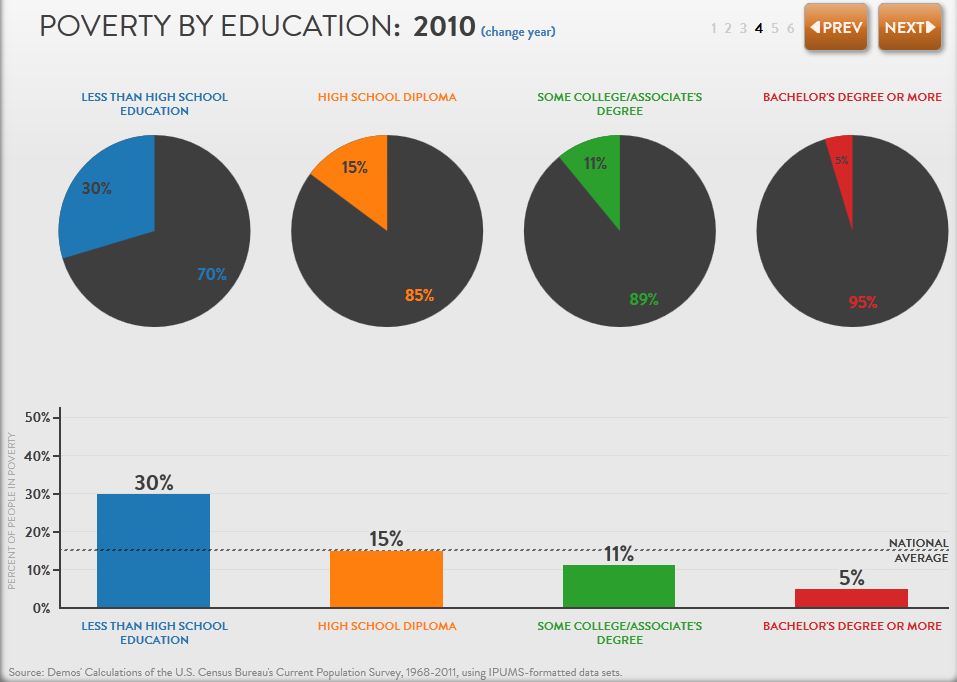 The question then becomes; what amount, if any, can a person or family living in or near the poverty level afford health insurance?
The question then becomes; what amount, if any, can a person or family living in or near the poverty level afford health insurance?
Is the right question even being asked? Maybe the question is not about affording health insurance, but being able to afford healthcare?
If we look further into those who are living in poverty, we see (unsurprisingly) that those with lesser levels of education are more likely to live in poverty.
As such, the question begs; do the uneducated and impoverished have the means and ability to log onto a website and accurately navigate to completion to apply for PPACA coverage?
2nd – Create an Offering
Once a need is determined and the marketplace identified, the next step is to craft an offering to suit the demand.
 Unfortunately, the results of the gyrations and contortions
Unfortunately, the results of the gyrations and contortions
necessary to get the Act passed through both the Senate and the House of Representatives and also signed into law by the President was an  Act that can only be described as an “Ugly Baby” – a legal “Rube Goldberg Machine”.
Act that can only be described as an “Ugly Baby” – a legal “Rube Goldberg Machine”.
Not even the President can seem to describe the Act, its specific benefits, and how it is intended to operate. As Albert Einstein famously said, “If you can’t explain it simply, you don’t understand it well enough.”
No matter how many articles I read, no matter how many summaries and “Wikipedia” references I dive into, and no matter how many times I visit the Kaiser Family Foundation – I still cannot make sense of the terms, conditions, processes (and their navigation) of the Act. Nor have I heard anyone who was able to clearly articulate such.
In some States, there is the option of private insurance or signing onto the States Medicaid. In others, it’s private insurance and the “exchanges” set-up by the Federal Government. The prices and coverage are nearly impossible to compare.
Most people will believe that the website(s) necessary to support the PPACA are at the heart of the failure. But I would argue that the real root-cause of the failure is the complexity in the construction of the Act itself.
Since nobody really understood the breadth or depth of the implications in the Act, the design of a website was all but impossible – with countless “exceptions” and changes being discovered during the design engineering and deployment phases. It all but assured the abject failure of the roll-out.
For this Second Stage of Creating an Offering, I believe it was Fatally Flawed from nearly every aspect imaginable and should never have been passed “just to pass something”.
3rd – Generate Market Awareness
Certainly, there was a lot of outbound communication regarding the PPACA, from all sources. Some communications were from proponents of the PPACA and some were from opponents. Some were (supposedly) knowledgeable of what the PPACA was to provide and how it was to work, but many sources of communication were entirely unknowledgeable. And all sides had their “talking heads”, sound-bites, and propagandists. From a consumer’s prospective, trying to become knowledgeable to the point of being able to make a reasoned decision became all but impossible.
But, if one considers that the primary beneficiaries of the PPACA were those who were in or near poverty and under-educated – well, it’s easy to predict the results that were experienced.
Even President Obama made statements which were inaccurate – if not outright wrong – on many occasions during the development of, and campaigning for the PPACA; with the most notable being in regards to “keeping you plan and your doctors, if you wish”.
Compare and contrast that miss-information with those who spoke of the creation of “Death Panels” – especially Fox News and Sarah Palin.
Who can the people turn to for accurate information if not from the Nation’s Leaders and News services?
It’s not unreasonable for people to want to get accurate information. Probably the most comprehensive source of information I found on the PPACA was at the Kaiser Family Foundation. I am certain that the under-educated would find the information on the website confusing, and there is bias in favor of the PPACA that makes every attempt to minimize its shortcomings and failings (from intent, to design, to deployment). For instance, there is an article published on October 29th that is entitled “Obamacare Vital Signs Not Just Numbers” – and this is anathema to any “Operational Excellence” professional.
But answers (even if biased) to most of the questions that a person might have can be found there.
Another topic which was inaccurately communicated were the costs – both to those who already had 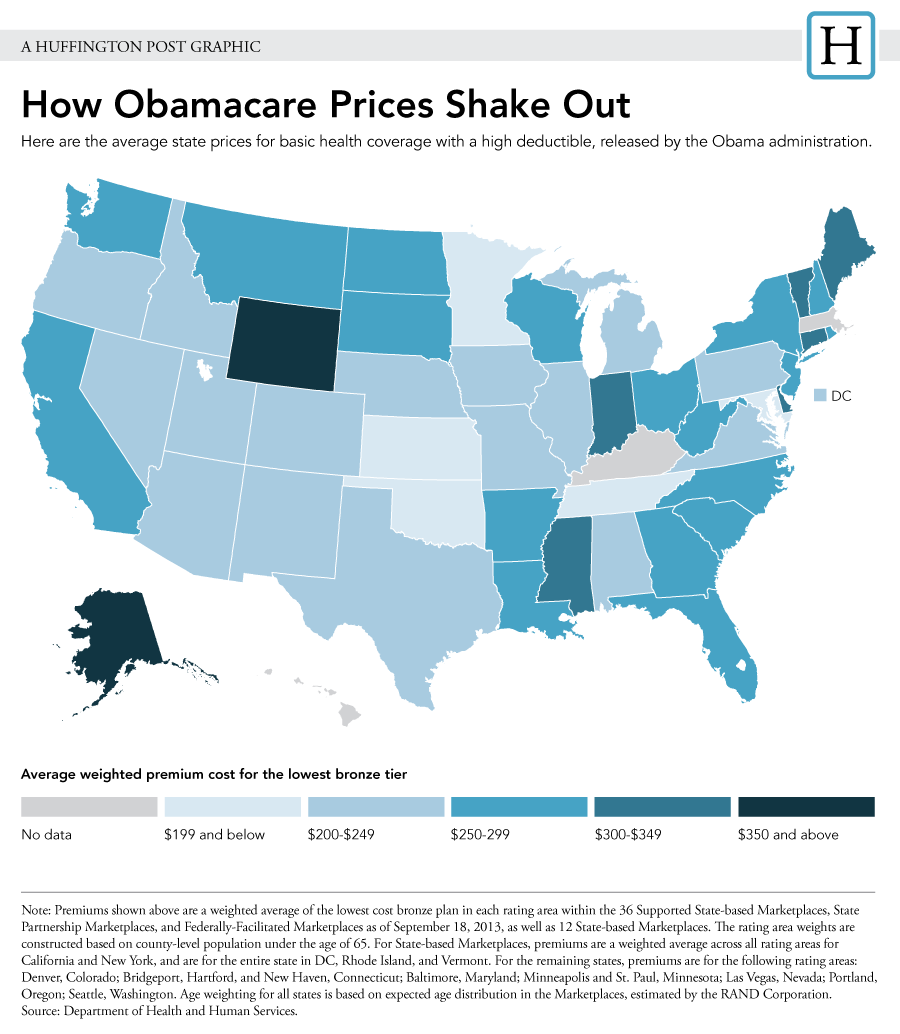 existing coverage and those who would soon be able to gain coverage. Those who had coverage were largely expecting no changes beyond the annual increases to which they have become accustomed (some were even expecting a decrease in their premium costs). And many of those who did not previously have coverage, but were looking forward to the opportunity for coverage, were expecting to obtain that coverage at no cost.
existing coverage and those who would soon be able to gain coverage. Those who had coverage were largely expecting no changes beyond the annual increases to which they have become accustomed (some were even expecting a decrease in their premium costs). And many of those who did not previously have coverage, but were looking forward to the opportunity for coverage, were expecting to obtain that coverage at no cost.
In the end, “There is no such thing as a free kitten”. Somebody always pays the party, but this should have been known and this should have been communicated openly and honestly.
4th – Expedite Purchase Execution by Consumer
 By any stretch of the imagination, the launch of the website(s) for, and related to, PPACA is completely off-the-rails and has been an abysmal failure – however measured. And to claim otherwise is simply a canard.
By any stretch of the imagination, the launch of the website(s) for, and related to, PPACA is completely off-the-rails and has been an abysmal failure – however measured. And to claim otherwise is simply a canard.
It is so bad, that the program has become a laughing-stock, destined to be a future idiom like “jumping the shark” – whose meaning is to “decline in quality to the point where it is beyond recovery” and whose origins is the “Happy Days” episode where Arthur “Fonzi” Fonzarelli literally jumps over a shark whilst waterskiing.
According to a report from CBS-News on October 31st, the goal of the systems is to enroll 39,000 subscribers a day – and 7 Million by April 30th. Citing a myriad of problems, on the first day of operation there were 4.7 Million “unique visitors” to the “Healthcare.gov” website on the first day – and a total of six (6) enrollments. According to a November 1st article in Bloomberg, after the first two (2) days in operation (October 1st thru 2nd) and with “direct enrollment still not working”, only 248 people had completed the registration process at the “Healthcare.gov” website with another 40,000 applicants with a status of “in process”.
The States which had set-up their own exchanges where having greater success with enrollment, since their websites are (largely) functioning more reliably and completely than the Federal website. But with success comes problems – namely, most of the applicants at the State-sponsored exchanges were destined for the Medicaid systems of those States, as opposed to private insurers. Although the analysis is incomplete, there is a risk that the increase in Medicaid participants might generate an ever-increasing and disproportionate burden on the taxpayer.
To illustrate, according to a November 1st article in the Washington Post and as the graphic from that article below demonstrates, those enrolling in the Medicaid programs of States that offer the option (of those who have reported) are far greater than those enrolling in plans offered by Private insurers.
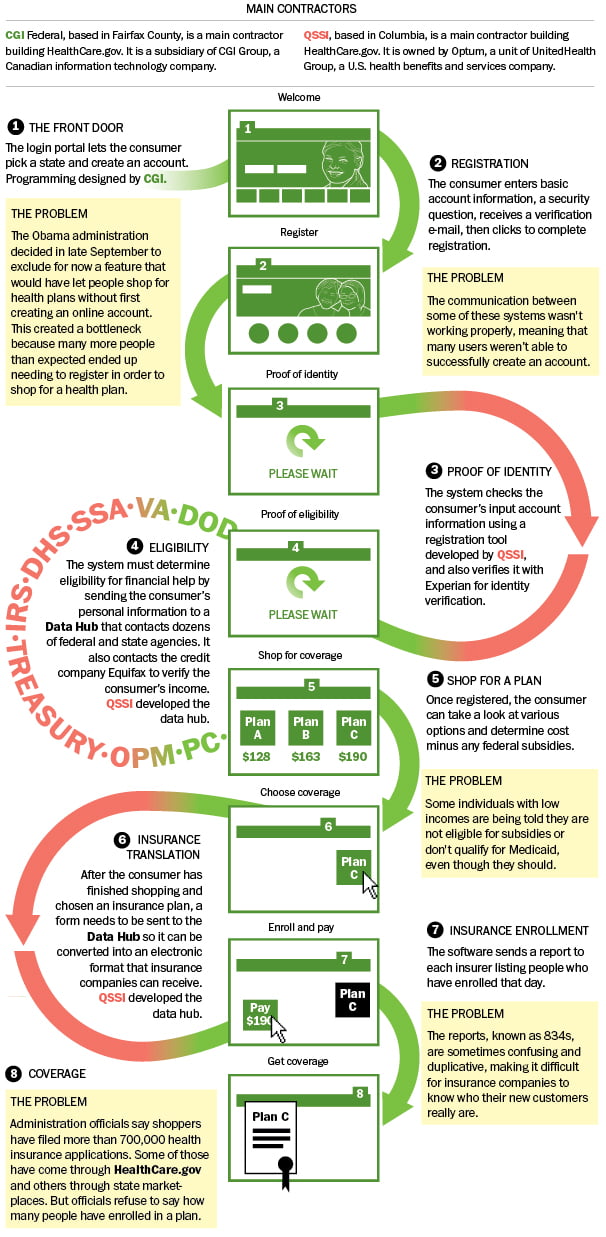 So, what went wrong with HealthCare.gov?
So, what went wrong with HealthCare.gov?
There are many who make the bold statement that the PPACA and its website is one of the largest and most complex projects ever undertaken by the Federal Government – ever.
Bigger than the Louisiana Purchase? Bigger than the Manhattan Project? Bigger than the Interstate Highway System? Bigger than the Apollo Program and the race to the moon?
It’s a website (see graphic) – and a complex website to be certain. And it’s a deal, but not a big deal. So it has a number of contractors, has to interface with a bunch of other systems – so what. Many others, with far fewer resources at their disposal, have done far more with greatly better results.
… Amazon, eBay, Google, Facebook – to name but a few. These are all far bigger deals than Healthcare.gov.
To see for myself, I tried (and failed miserably) to apply for insurance coverage through the exchange. In the few opportunities I had to actually begin the process (the site kept crashing on me), I didn’t get far before I was thwarted by some required piece of information which I didn’t understand.
And given my suspicion that the site was not well engineered and well designed, I was very hesitant to provide my personal information (name, address, date-of-birth, and social security number) not for any “HIPAA” concerns, but concerns over “Identity Theft”.
… I even called the phone number to apply via telephone where I was on hold for 1hr-12min before someone answered – and even then, could not begin to take my information.
According to a November 1st article in Bloomberg, the condition and state-of-readiness of the Healthcare.gov website is so bad that Google and Facebook have volunteered to contribute their software engineering resources to overcome the problems. Calling it a “Tech Surge”, the Federal Government has accepted.
And the customers? What became of the intended customers of the system? They have become even more confused and skeptical – and increasingly less likely to engage. And why should they, really?
Those people who are the intended beneficiaries of the PPACA are sidelined. From the specifications of the Act, through the attempts of deployment, I feel the “voice of the customer” was never heard – I am not even sure reaching out was ever considered.
How far and how deep is this new-found cynicism? People don’t make fun of the successful – certainly we don’t hold them to ridicule. We never see skits on Saturday Night Live (SNL) poking fun or otherwise ridiculing Steve Jobs, Apple and Pixar, or anything associated with the person or the company. The same is true of Elon Musk and his companies PayPal, Tesla or SpaceX; or Sir Richard Branson of the Virgin Group of Companies, or Larry Ellison of Oracle.
People are also kind to those who tried and failed – so long as they are humble as a person and even possess an appreciation of self-deprecating humor. For instance, take Groucho Marx when he said; “I don’t care to belong to any club that will have me as a member.”
But people are ruthless when it comes to hubris undeserved or, better yet, failed.
So, you know you have reached the pinnacle of the absurd when people roast you and your program on Saturday Night Live and Jon Stewart. You know you have arrived in this hallowed ground of the anti-hero when someone (many in this case) have created a “Hitler Rant”.
And, being a Politician especially, you know things are bad when your allies talk about the “warm and fuzzies” of what can be, what will be – someday – but not yet.
In Summary
The launch of the PPACA, while a significant and controversial undertaking should have been able to be conceived, designed, approved, and deployed in a professional manner – but it wasn’t.
I believe a solution could have been found where everyone in the States could have been covered by health insurance; and the focus should have turned to improving the quality of healthcare and managing the associated costs – but it wasn’t.
I believe there could have been an effective partnership between Federal, State, and the Private Sector to develop health insurance schemes and focus on healthcare value and simplicity – but it wasn’t.
I believe that an organization for educating and counseling the citizenry so they can make properly informed decisions, and the infrastructure and systems (technical and otherwise) to manage their participation, could have been devised and deployed in advance of the program’s launch – but it wasn’t.
And, given understandable system requirements with specifications and business rules that were known and static, I believe that a system could have been developed and launched successfully – but it wasn’t.
 It’s not too late. The Nation’s Leaders – both in the public and private sectors – should get back to work and do what is necessary to fix what is obviously broken. And I am not referring to just the website(s).
It’s not too late. The Nation’s Leaders – both in the public and private sectors – should get back to work and do what is necessary to fix what is obviously broken. And I am not referring to just the website(s).
But for now; we all have to buy a policy we can’t understand, through a system that doesn’t work – and if we don’t, we are going to get fined*.
“Caveat Emptor” – Let the buyer beware.
About the Author
 Joseph F Paris Jr is the Founder and Chairman of the XONITEK Group of Companies; an international management consultancy firm specializing in all disciplines related to Operational Excellence, the continuous and deliberate improvement of company performance AND the circumstances of those who work there – to pursue “Operational Excellence by Design” and not by coincidence.
Joseph F Paris Jr is the Founder and Chairman of the XONITEK Group of Companies; an international management consultancy firm specializing in all disciplines related to Operational Excellence, the continuous and deliberate improvement of company performance AND the circumstances of those who work there – to pursue “Operational Excellence by Design” and not by coincidence.
He is also the Founder of the Operational Excellence Society, with hundreds of members and several Chapters located around the world, as well as the Owner of the Operational Excellence Group on Linked-In, with over 25,000 members.
For more information on Paris, please check his Linked-In Profile at: http://de.linkedin.com/in/josephparis


